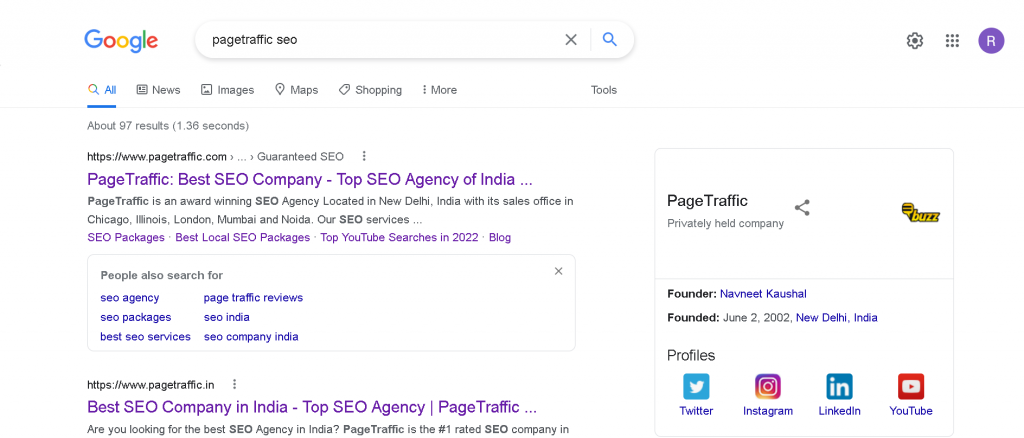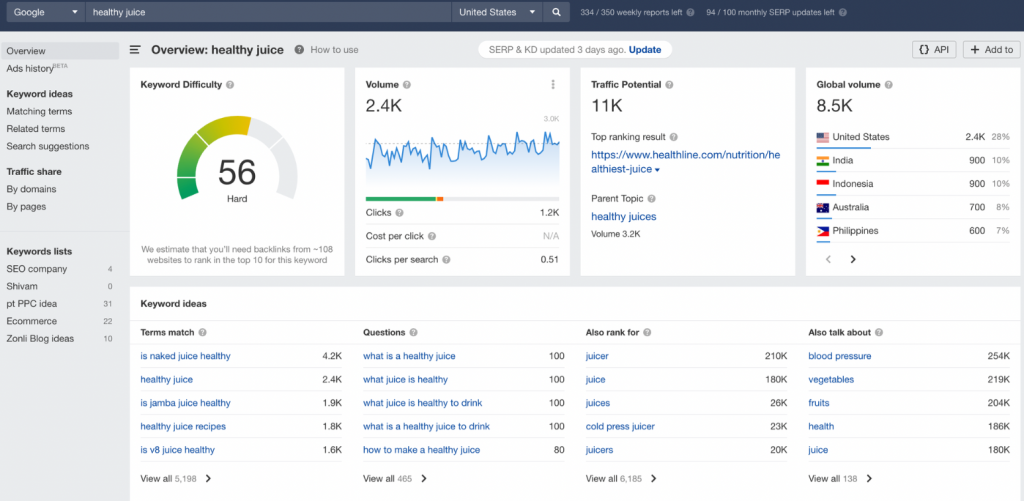Google launched a new feature called "People Also Search For" at the beginning of 2018. The feature only appears to users after they have clicked on a search result and are instantly returned to the Google search engine results page. Google uses the keywords in the "People Also Search For" box to recommend related queries to users who may not be aware of them. These keywords have also been searched for by users who have also typed in the primary query.
For example, a searcher might want to know “how to do content marketing” and they may make a search for the term “content marketing.” Google will show a bunch of articles showing “what is content marketing,” and it may not be what an individual is searching for.
The People Also Search For snippet will then show search terms like “content marketing strategies” or “content marketing examples” and a user can click on those related terms to find articles about how to “how to actually do content marketing.”
It is a means by which Google may enhance its search results and assist users in finding precisely what they're looking for.
I'll go into more detail about People Also Search For, various highlighted snippet formats in Google, and how to rank for these kinds of keywords in the remaining sections of this post.
We will cover the following topics (please click on each section):
What happens is that none of these results may be what the user is looking for. So when a user clicks into an article, then clicks the back button, the People Also Search For snippet pops up.
It looks like this:
3 Ways To Use “People Also Search For (PASF)” To Rank Higher In Google Search?
PASF ranking is very similar to PAA ranking. Your goal should still be to anticipate user questions and provide prompt responses while also fleshing out answers in a thorough manner.
The main distinction between ranking for PASF and ranking for PAA is how you research what users are looking for. To get Google’s suggested PASF listings, you must conduct your own searches, click on websites, and quickly hit the back button.
After that, you can proceed with the PAA ranking process. This way, you can increase your chances of ranking for both PAA and PASF while also increasing traffic to your website!
Create an outstanding outline
Once you have decided on a keyword and understand the search intent, it is time to create a content outline.
You can create an SEO outline for your article using a tool. All you have to do is type in your desired keyword and generate a report. The report will show you related keywords you should include in your article as well as ideas for what you should discuss.
It is an excellent way to ensure that your articles are fully optimized for Google. Optimization is essential for driving traffic to your articles, so if you are serious about driving organic traffic to your website, you should definitely use the best SEO tools.
You must first capture Google’s attention before you can impress audiences with your answers. That includes writing headlines that attract the attention of Google’s web crawling bots.
To put it simply, the headlines you use should include specific keywords. These are the primary keywords on which your content will be based. However, the headlines must also be descriptive. You cannot simply stuff keywords into there. Instead, descriptive headers and subheaders are required (ideally, ones formatted as questions).
This method of formatting your content is a true “win/win.” It boosts your overall SEO while increasing your chances of ranking.
Search Intent
The most important ranking factor is determining intent for a given keyword. Simply searching for a keyword in Google will reveal search intent.
For example, if I search for “content marketing,” the top three ranking web pages are articles about “What is content marketing?” This tells that Google prefers to rank articles about “what is content marketing” for this keyword. Google has determined that this is the search intent of people who search for this term.
Finding PASF topics to go after
You can begin by simply revising your existing content. However, whether you are revising old content or creating new content, you must focus on selecting the appropriate topic and keywords. This will help you create a knowledge graph and show Google that you have topical authority over a given topic.
Some of this entails sitting down and brainstorming “common sense” questions that audiences might have about a specific subject. This can assist you in developing content to write about (as well as keywords to use) that will answer the questions they are likely to have.
Always keep an eye on what your competitors are up to. If they are not answering certain questions or explaining certain topics sufficiently, your company can take the lead in these areas.
Frequently Asked Questions
1. How to find what people are searching for?
In order to find what people are searching for you can use The “People Also Search For” feature used by search engines like Google. Here’s how you can use this feature:
- Go to Google and perform a search query for a particular topic.
- Scroll to the bottom of the search results page and look for the “People Also Search For” section. This section will display a list of related search queries that people have used.
- Use the information from the “People Also Search For” section to gain insights into the topics that people are interested in and adjust your content accordingly.
Bear in mind that the “People Also Search For” feature is generated dynamically based on the search query and the user’s location and search history. This means that the results may differ for different users. However, it can still provide valuable information and help you understand what people are searching for.
2. What is Google PAA or PASF?
These are two titles referring to two different suggestion boxes Google and other search engines provide. PAA means people also ask, and PASF stands for people also searched for. Both options provide you with the same benefits as mentioned above.
3. People Also Search For (PASF) vs People Also Ask (PAA)?
There is a slight distinction between these two suggestion boxes Google and other search engines provide. The PASF is keywords Google already knows internet users have used to make searches. This takes place AFTER they made their initial search.
PAA are simply questions internet users ask that are related to their topic and a given keyword they have used for their search. The PAA is not necessarily keywords but actual questions users ask. These will also provide ideas you can use for your website or blog.
4. How does Google’s ‘People Also Searched For’ work?
It works by analyzing the search queries of other users who have searched for similar terms and then displaying those results in a list. This helps you find more relevant information on the topic you’re researching, as well as gives you ideas for new topics to explore. By using this feature, you can quickly expand your knowledge base and gain insights into what other people are searching for online.
3 Best Tools to Find PASF Keywords
If you are still not sure about how to find PASF keywords, then read this section to know about the 3 best tools you can use for the task. These tools have free as well as paid versions available that can complete your task in just minutes.
Keywords Everywhere
One of the best SEO tools for viewing data directly on your search page is Keywords Everywhere Google Chrome extension. You can get access to both ‘Related Keywords’ and PASF keywords with this tool. These outcomes are generally pretty similar and easy to understand.
Every search result on the SERP pulls up six related topics (PASF keywords) that go with it. You can see the six keywords related to your search query by clicking on the top widget that contains the related terms to your search query. The Keywords Everywhere browser extension automatically finds the six keywords embedded in the SERP for each search result, gets rid of the duplicates, and shows them to you on the right side of Google in a widget called “People Also Search For,” along with the monthly search volume, CPC, and competition.
Google SERPs
There are instances when the Search Engine Result Pages (SERPs) provided by Google are the most effective tools for locating PASF inquiries. Using Google search, you can find other relevant queries and related pages that people look for. These are the terms that people are using at the moment to find things online. Because they can be the terms that have only been searched very lately, keyword research tools might not always be able to uncover them.
The People Also Ask (PAA) section of Google is yet another resource that can be utilized for the direct discovery of keywords. With the assistance of the PAA section, it should not be difficult to come up with material and ideas for blog posts to explore.
Google’s search engine results page (SERP) is updated constantly with fresh results and search strategies. One more time, this is because Google strives to bring an end as quickly as possible to the search experience of its users.
Ahrefs
There are not many tools that are as useful and efficient as Ahrefs when it comes to keyword research. It is one of the tools that content management teams use the most frequently since it has produced the best results for helping websites obtain high search rankings that increase traffic.
You will see more than simply PASF keywords with Ahrefs. It can display a wide range of other keyword suggestions as well as items like ‘Questions,’ which are taken from Google’s People Also Ask (PAA) section.
The tool commonly used for generating "People Also Ask" (PAA) suggestions is known as "Answer Box Explorer" or "PAA Box Explorer." This tool is utilized by SEO (Search Engine Optimization) professionals and content creators to identify related questions that appear in the "People Also Ask" section of search engine results pages (SERPs).
By using this tool, content creators can gain insights into what questions users are asking, enabling them to optimize their content and provide relevant answers to these queries. Please note that other similar tools might also exist with slightly different names or functionalities, but "Answer Box Explorer" is a commonly recognized term for this type of tool.
What Can You Do To Manage Duplicate PASF Topics
With the number of PASF topics available, it can be difficult to know what to focus on and how to manage duplicate PASF topics. Here are three things to do:
One Landing Page for Related Queries
The next thing you can do is to create a single landing page where you can group all of your relevant links in that page. In this way, you are telling Google that your content is not duplicate.
Make Use of Canonical Tags
In order to avoid duplicate PASF topics you can use canonical tags. Canonical tags are used in SEO to tell Google which version of a page you want to show in search results, to consolidate link equity from duplicate pages, and to make your website easier to crawl and index.
Redirect Users
From your landing page you can redirect your users to other related content. This will also help SEO since Google will see your site as a hub of information for that particular niche.
Conclusion
People Also Search For is an excellent way for marketers to discover keyword ideas that they might not have discovered otherwise.
The great thing about PASF keywords is that they provide information directly from Google. It is not the result of a keyword research tool. As a result, these keywords can be extremely valuable because they are terms that people are looking for in real time.
Conclusion
One of the best and free resources you have for ideas for your content and website are found in the PASF section. These suggestions will help you find keywords, topics to write about, or questions to answer.
They are a gold mine of information as well as SEO ranking help. It would be a good idea to mine this area the next time you are stuck for keywords, an outline, or content to write on.
Furthur More: read this people also search for blog, help your to boost your website organic traffic anf helpin you to better rank in google search result.
https://aksoftco.com/web-development-company-near-me/
https://www.marketermilk.com/blog/people-also-search-for
https://seowind.io/people-also-search-for/
https://www.pagetraffic.com/blog/people-also-search-for/
https://inboundjunction.com/google-people-also-search-for-seo
https://www.seoinc.com/seo-blog/people-also-search-for/
https://keywordseverywhere.com/people-also-search-for.html
https://www.marketermilk.com/blog/people-also-search-for










